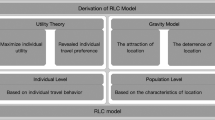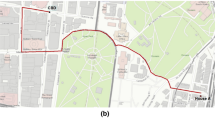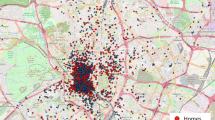Abstract
The Huff model is designed to estimate the probability of shopping centre patronage based on a shopping centre’s attractiveness and the cost of a customer’s travel. In this paper, we attempt to discover some general shopping trends by calibrating the Huff model in Shenzhen, China, and New York, USA, using taxi trajectory GPS data and sharing bikes GPS data. Geographical and Temporal Weighted Regression (GTWR) is used to fit the model, and calibration results are compared with Ordinary Least Squares (OLS) regression, Geographical Weighted Regression (GWR), and Temporal Weighted Regression (TWR). Results show that GTWR gives the highest performance due to significant geographical and temporal variation in the Huff model parameters of attractiveness and travel cost. To explain the geographical variation, we use residential sales’ and rental prices in Shenzhen and New York as a proxy for customers’ wealth in each region. Pearson product-moment correlation results show a medium relationship between localised sales’ and rental prices and the Huff model parameter of attractiveness: that is, customer wealth explains geographic sensitivity to shopping area attractiveness. To explain temporal variation, we use census data in both Shenzhen and New York to provide job profile distributions for each region as a proxy to estimate customers’ spare leisure time. Regression results demonstrate that there is a significant linear relationship between the length of spare time and the parameter of shopping area attractiveness. In particular, we demonstrate that wealthy customers with less spare time are more sensitive to a shopping centre’s attractiveness. We also discover customers’ sensitivities to travel distance are related to their travel mode. In particular, people riding bikes to shopping areas care much more about trip distance compared with people who take taxi. Finally, results show a divergence in behaviours between customers in New York and Shenzhen at weekends. While customers in New York prefer to shop more locally at weekends, customers in Shenzhen care less about trip distance. We provide the GTWR calibration of the Huff model as our theoretical contribution. GTWR extends the Huff model to two dimensions (time and space), so as to analyse the differences of residents’ travel behaviours in different time and locations. We also provide the discoveries of factors affecting urban travel behaviours (wealth and employment) as practical contributions that may help optimise urban transportation design. In particular, the sensitivity of residents to the attraction of shopping areas has a significant positive linear relationship with the housing price and a significant negative linear relationship with the residents’ length of spare time.












Similar content being viewed by others
Notes
For example, Bayesian Average is used by Internet Movie Data Base (IMDB; imdb.com), the world’s most popular source for movie, TV and celebrity content.
A multiplicative model was also considered, such that attractiveness, S, is calculated as a linear function of size, reviews, and number of journeys. However, results showed that the three variables are colinear, thus rendering the model unusable.
These data were collected from an open source website fang.com, which is the largest and most comprehensive open source repository for house price sales in China.
The data of the 6th national population census is available open source from http://www.stats.gov.cn/ztjc/zdtjgz/zgrkpc/dlcrkpc/dlcrkpczl.
The open source website is: sz.58.com.
The open source questionnaire website is: https://opendata.cityofnewyork.us
References
Bohnet M, Gutsche JM (2007) Estimating land use impacts on transportation—findings from the Hanover region. In: Proceedings of the European Transport Conference Association for European Transport. Leiden, The Netherlands
Brunsdon C, Fotheringham AS, Charlton ME (1996) Geographically weighted regression: a method for exploring spatial nonstationarity. Geograp Anal 28(4):281–298
Bureau WTP (2009) Wuhan traffic impact analysis guideline. Technical report, Wuhan Transportation Planning Bureau
Cardozo OD, García-Palomares JC, Gutiérrez J (2012) Application of geographically weighted regression to the direct forecasting of transit ridership at station-level. Appl Geograph 34:548–558
Cartlidge J, Ait-Boudaoud D (2011) Autonomous virulence adaptation improves coevolutionary optimization. IEEE Trans Evol Comput 15(2):215–229. https://doi.org/10.1109/TEVC.2010.2073471
Cartlidge J, Gong S, Bai R, Yue Y, Li Q, Qiu G (2018) Spatio-temporal prediction of shopping behaviours using taxi trajectory data. In: 2018 IEEE 3rd International Conference on Big Data Analysis (ICBDA), pp 112–116. https://doi.org/10.1109/ICBDA.2018.8367660
Chu C (1989) A paired combinatorial logit model for travel demand analysis. In: Transport Policy, Management & Technology Towards 2001: Selected Proceedings of the Fifth World Conference on Transport Research. World Conference on Transport Policy, Yokohama, vol 4, pp 295–309
Chu X (2004) Ridership models at the stop level. Technical report, National Center for Transit Research, University of South Florida
Estupinán N, Rodríguez DA (2008) The relationship between urban form and station boardings for Bogota’s BRT. Transp Res Part A: Policy Practice 42(2):296–306
Gong L, Liu X, Wu L, Liu Y (2016) Inferring trip purposes and uncovering travel patterns from taxi trajectory data. Cartogr Geogr Inf Sci 43(2):103–114
Gong S, Cartlidge J, Yue Y, Qiu G, Li Q, Xin J (2017) Geographical Huff model calibration using taxi trajectory data. In: Proceedings of the 10th ACM SIGSPATIAL Workshop on Computational Transportation Science, IWCTS’17. ACM, New York, pp 30–35. https://doi.org/10.1145/3151547.3151553
Gong S, Cartlidge J, Bai R, Yue Y, Li Q, Qiu G (2018) Automated prediction of shopping behaviours using taxi trajectory data and social media reviews. In: 2018 IEEE 3rd International Conference on Big Data Analysis (ICBDA), pp 117–121. https://doi.org/10.1109/ICBDA.2018.8367661
Gong S, Cartlidge J, Bai R, Yue Y, Li Q, Qiu G (2019a) Activity modelling using journey pairing of taxi trajectory data. In: 2019 IEEE 4th International Conference on Big Data Analytics (ICBDA), pp 236–240. https://doi.org/10.1109/ICBDA.2019.8712832
Gong S, Cartlidge J, Bai R, Yue Y, Li Q, Qiu G (2019b) Extracting activity patterns from taxi trajectory data: a two-layer framework using spatio-temporal clustering, bayesian probability and monte carlo simulation. Int J Geogr Inf Sci:1–25. https://doi.org/10.1080/13658816.2019.1641715
Gracia A, de Magistris T (2008) The demand for organic foods in the South of Italy: A discrete choice model. Food Policy 33(5):386–396
Gutiérrez J, Cardozo OD, García-Palomares JC (2011) Transit ridership forecasting at station level: an approach based on distance-decay weighted regression. J Transport Geograph 19(6):1081–1092
Huff DL (1964) Defining and estimating a trading area. J Market 28(5):34–38
Li Y, Yang L, Shen H, Wu Z (2019) Modeling intra-destination travel behavior of tourists through spatio-temporal analysis. J Destinat Market Manag 11:260–269
Lloyd CD (2010) Local models for spatial analysis. CRC Press, Boca Raton
Lu B, Charlton M, Harris P, Fotheringham AS (2014) Geographically weighted regression with a non-euclidean distance metric: a case study using hedonic house price data. Int J Geogr Inf Sci 28(4):660–681
Ma X, Zhang J, Ding C, Wang Y (2018) A geographically and temporally weighted regression model to explore the spatiotemporal influence of built environment on transit ridership. Comput Environ Urban Syst 70:113–124
Mao F, Ji M, Liu T (2016) Mining spatiotemporal patterns of urban dwellers from taxi trajectory data. Front Earth Sci 10(2):205–221
Nakanishi M, Cooper LG (1974) Parameter estimation for a multiplicative competitive interaction model: least squares approach. Journal of marketing research, pp 303–311
NYC-OpenData (2018) 2015 Yellow Taxi Trip Data. https://data.cityofnewyork.us/Transportation/2015-Yellow-Taxi-Trip-Data/ba8s-jw6u, accessed June, 2018
O’Kelly ME (1999) Trade-area models and choice-based samples: methods. Environ Plann A 31(4):613–627
Olsson G (1970) Explanation, prediction, and meaning variance: an assessment of distance interaction models. Econ Geogr 46(sup1):223–233
Rashidi TH, Abbasi A, Maghrebi M, Hasan S, Waller TS (2017) Exploring the capacity of social media data for modelling travel behaviour: Opportunities and challenges. Transp Res Part C: Emerging Technol 75:197–211
Rodrigue JP, Comtois C, Slack B (2013) The geography of transport systems. Routledge, New York, p 10017
da Silva AR, Fotheringham AS (2016) The multiple testing issue in geographically weighted regression. Geogr Anal 48(3):233–247
Southworth F (1983) Temporal versus other impacts upon trip distribution model parameter values. Reg Stud 17(1):41–47
Suárez-Vega R, Gutiérrez-Acuna JL, Rodríguez-Díaz M (2015) Locating a supermarket using a locally calibrated huff model. Int J Geograph Inf Sci 29(2):217–233
Tang J, Jiang H, Li Z, Li M, Liu F, Wang Y (2016) A Two-Layer Model for Taxi Customer Searching Behaviors Using GPS Trajectory Data. IEEE Trans Intell Transp Syst 17(11):3318–3324
Wang P, Fu Y, Liu G, Hu W, Aggarwal C (2017) Human Mobility Synchronization and Trip Purpose Detection with Mixture of Hawkes Processes. In: Proceedings of the 23rd ACM SIGKDD International Conference on Knowledge Discovery and Data Mining. ACM, pp 495–503
Wang P, Fu Y, Zhang J, Li X, Lin D (2018a) Learning urban community structures: a collective embedding perspective with periodic spatial-temporal mobility graphs. ACM Trans Intell Syst Technol (TIST) 9(6):63
Wang P, Zhang J, Liu G, Fu Y, Aggarwal CC (2018b) Ensemble-spotting: Ranking urban vibrancy via POI embedding with multi-view spatial graphs. In: Proceedings of the 2018 SIAM International Conference on Data Mining, SDM 2018, San Diego Marriott Mission Valley, San Diego, pp 351–359
Yan XY, Wang WX, Gao ZY, Lai YC (2017) Universal model of individual and population mobility on diverse spatial scales. Nat Commun 8(1):1639
Yang X, Zhang Z (2013) Combining prestige and relevance ranking for personalized recommendation. In: Proceedings of the 22nd ACM international conference on Conference on information and knowledge management, pp 1877–1880
Yue Y, Zhuang Y, Li Q, Mao Q (2009) Mining time-dependent attractive areas and movement patterns from taxi trajectory data. In: 2009 17th International Conference on Geoinformatics. IEEE, pp 1–6
Yue Y, Hu B et al (2011) Identifying shopping center attractiveness using taxi trajectory data. In: Proceedings of the 2011 international workshop on Trajectory data mining and analysis. ACM, pp 31–36
Yue Y, Hd Wang, Hu B, Li Q q, Li Y g, Yeh AG (2012) Exploratory calibration of a spatial interaction model using taxi GPS trajectories. Comput Environ Urban Syst 36(2):140–153
Zhang J, Zheng Y, Qi D, Li R, Yi X (2016) DNN-based prediction model for spatio-temporal data. In: Proceedings of the 24th ACM SIGSPATIAL International Conference on Advances in Geographic Information Systems. ACM, p 92
Acknowledgements
This research was supported by the International Doctoral Innovation Centre, Ningbo Education Bureau, the University of Nottingham, Zhejiang Natural Science Foundation (Grant No. LR17G010001), Ningbo Science and Technology Bureau (Grant No. 2014A35006, 2017D10034), UK Engineering and Physical Sciences Research Council (Grant No. EP/L015463 /1), the National Science Foundation of China (No. 71471092), the Zhejiang Lab’s International Talent Fund for Young Professionals, Shenzhen Scientific Research and Development Funding Program (No. CXZZS20150504141623042). John Cartlidge is sponsored by Refinitiv.
Author information
Authors and Affiliations
Corresponding author
Additional information
Publisher’s note
Springer Nature remains neutral with regard to jurisdictional claims in published maps and institutional affiliations.
Rights and permissions
About this article
Cite this article
Gong, S., Cartlidge, J., Bai, R. et al. Geographical and temporal huff model calibration using taxi trajectory data. Geoinformatica 25, 485–512 (2021). https://doi.org/10.1007/s10707-019-00390-x
Received:
Revised:
Accepted:
Published:
Issue Date:
DOI: https://doi.org/10.1007/s10707-019-00390-x




